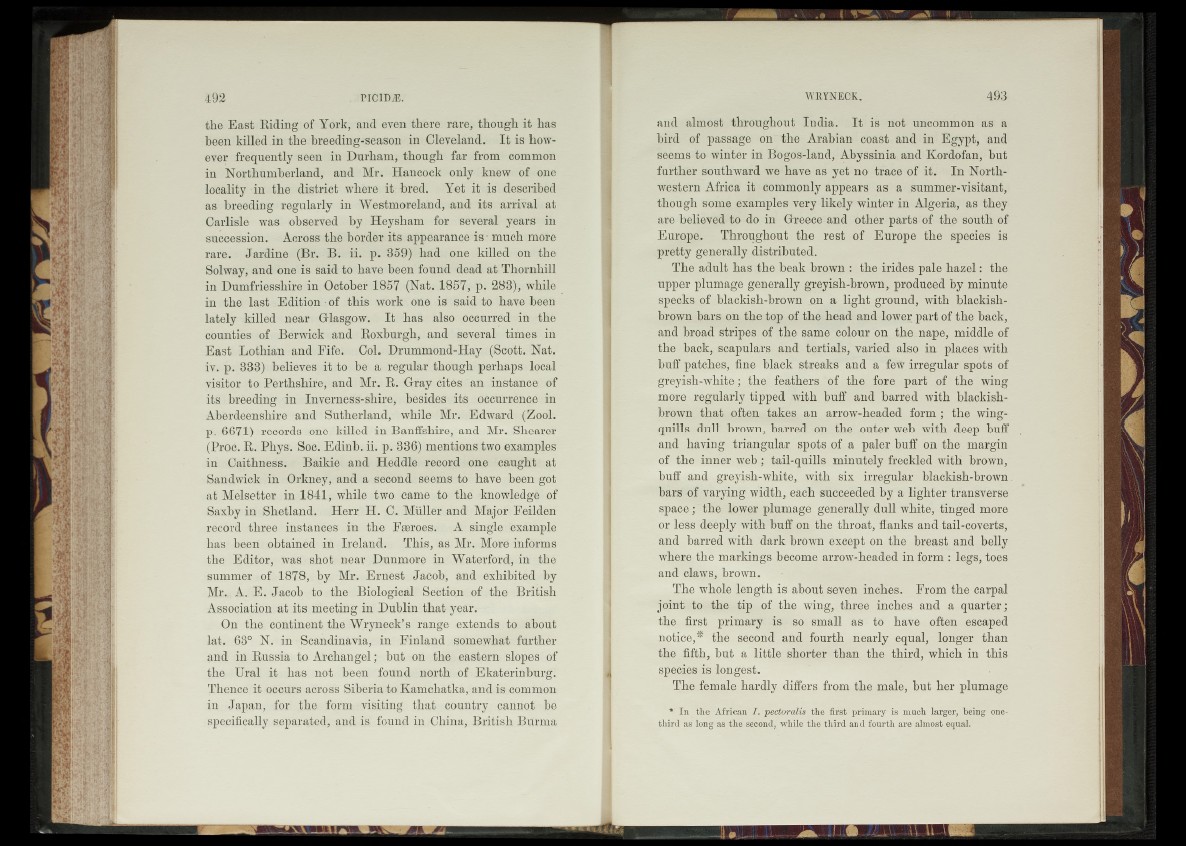
the East Riding of York, and even there rare, though it has
been killed in the breeding-season in Cleveland. It is however
frequently seen in Durham, though far from common
in Northumberland, and Mr. Hancock only knew of one
locality in the district where it bred. Yet it is described
as breeding regularly in Westmoreland, and its arrival at
Carlisle was observed by Heysham for several years in
succession. Across the border its appearance is - much more
rare. Jardine (Br. B. ii. p. 359) had one killed on the
Solway, and one is said to have been found dead at Thornhill
in Dumfriesshire in October 1857 (Nat. 1857, p. 288), while
in the last Edition ■ of this work one is said to have been
lately killed near Glasgow. It has also occurred in the
counties of Berwick and Roxburgh, and several times in
East Lothian and Fife. Col. Drummond-Hay (Scott. Nat.
iv. p. 333) believes it to be a regular though perhaps local
visitor to Perthshire, and Mr. R. Gray cites an instance of
its breeding in Inverness-shire, besides its occurrence in
Aberdeenshire and Sutherland, while Mr. Edward (Zool.
p. 6671) records one killed in Banffshire, and Mr. Shearer
(Proc. R. Phys. Soc. Edinb. ii. p. 336) mentions two examples
in Caithness. Baikie and Heddle record one caught at
Sandwick in Orkney, and a second seems to have been got
at Melsetter in 1841, while two came to the knowledge of
Saxby in Shetland. Herr H. C. Muller and Major Feilden
record three instances in the Faeroes. A single example
has been obtained in Ireland. This, as Mr. More informs
the Editor, was shot near Dunmore in Waterford, in the
summer of 1878, by Mr. Ernest Jacob, and exhibited by
Mr. A. E. Jacob to the Biological Section of the British
Association at its meeting in Dublin that year.
On the continent the Wryneck’s range extends to about
lat. 63° N. in Scandinavia, in Finland somewhat further
and in Russia to Archangel; but on the eastern slopes of
the Ural it has not been found north of Ekaterinburg.
Thence it occurs across Siberia to Kamchatka, and is common
in Japan, for the form visiting that country cannot be
specifically separated, and is found in China, British Burma
and almost throughout India. It is not uncommon as a
bird of passage on the Arabian coast and in Egypt, and
seems to winter in Bogos-land, Abyssinia and Kordofan, but
further southward we have as yet no trace of it. In Northwestern
Africa it commonly appears as a summer-visitant,
though some examples very likely winter in Algeria, as they
are believed to do in Greece and other parts of the south of
Europe. Throughout the rest of Europe the species is
pretty generally distributed.
The adult has the beak brown : the irides pale hazel: the
upper plumage generally greyish-browm, produced by minute
specks of blackish-brown on a light ground, with blackish-
brown bars on the top of the head and lower part of the back,
and broad stripes of the same colour on the nape, middle of
the back, scapulars and tertials, varied also in places with
buff patches, fine black streaks and a few irregular spots of
greyish-white; the feathers of the fore part of the wing
more regularly tipped with buff and barred with blackish-
brown that often takes an arrow-headed form ; the wing-
quills dull brown, barred on the outer web with deep buff
and having triangular spots of a paler buff on the margin
of the inner web; tail-quills minutely freckled with brown,
buff and greyish-white, with six irregular blackish-brown
bars of varying width, each succeeded by a lighter transverse
space; the lower plumage generally dull white, tinged more
or less deeply with buff on the throat, flanks and tail-coverts,
and barred with dark brown except on the breast and belly
where the markings become arrow-headed in form : legs, toes
and claws, brown.
The whole length is about seven inches. From the carpal
joint to the tip of the wing, three inches and a quarter;
the first primary is so small as to have often escaped
notice,* the second and fourth nearly equal, longer than
the fifth, but a little shorter than the third, which in this
species is longest.
The female hardly differs from the male, but her plumage
* In the African I. pectoralis the first primary is much larger, being one-
third as long as the second, while the third and fourth are almost equal.